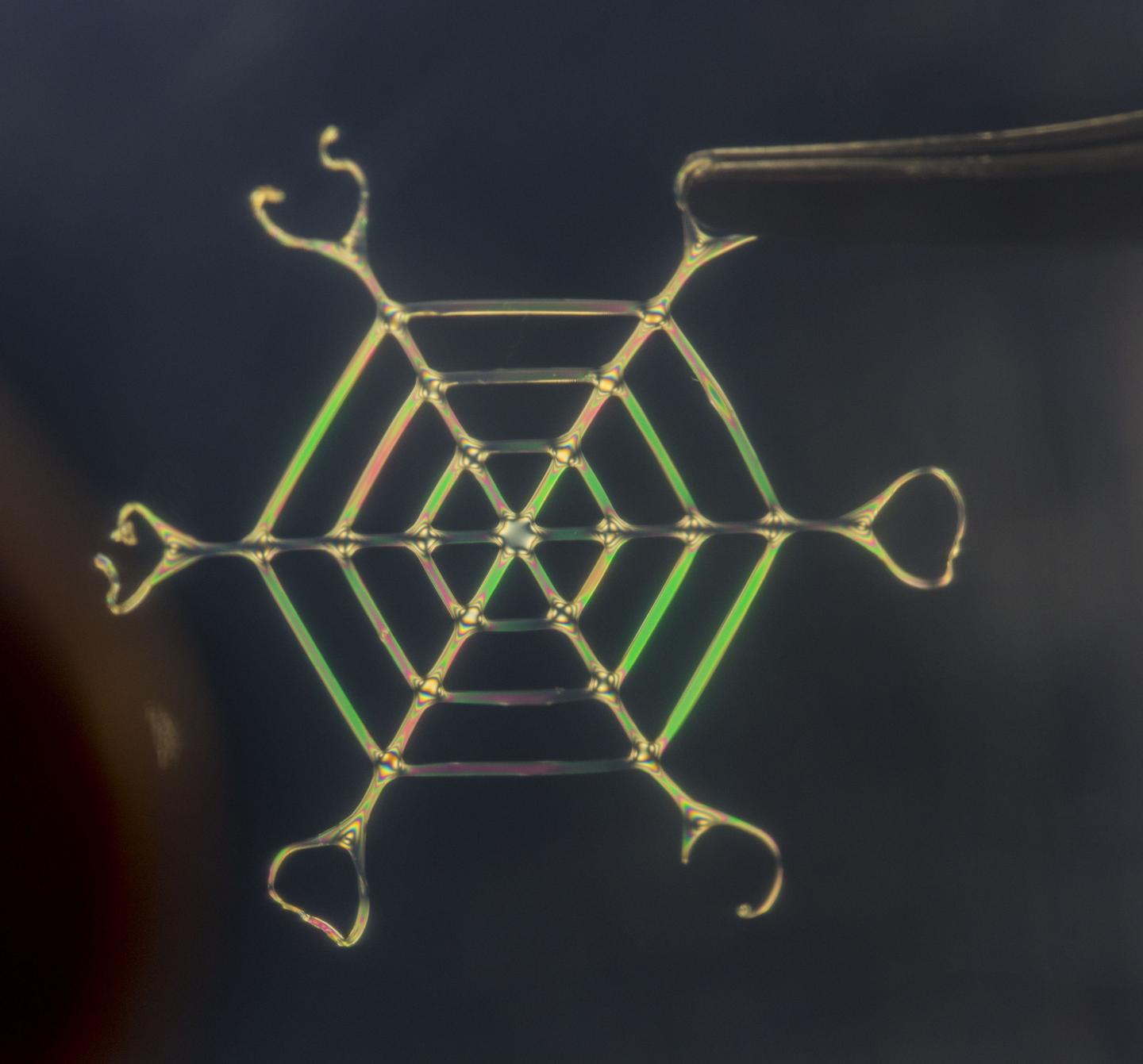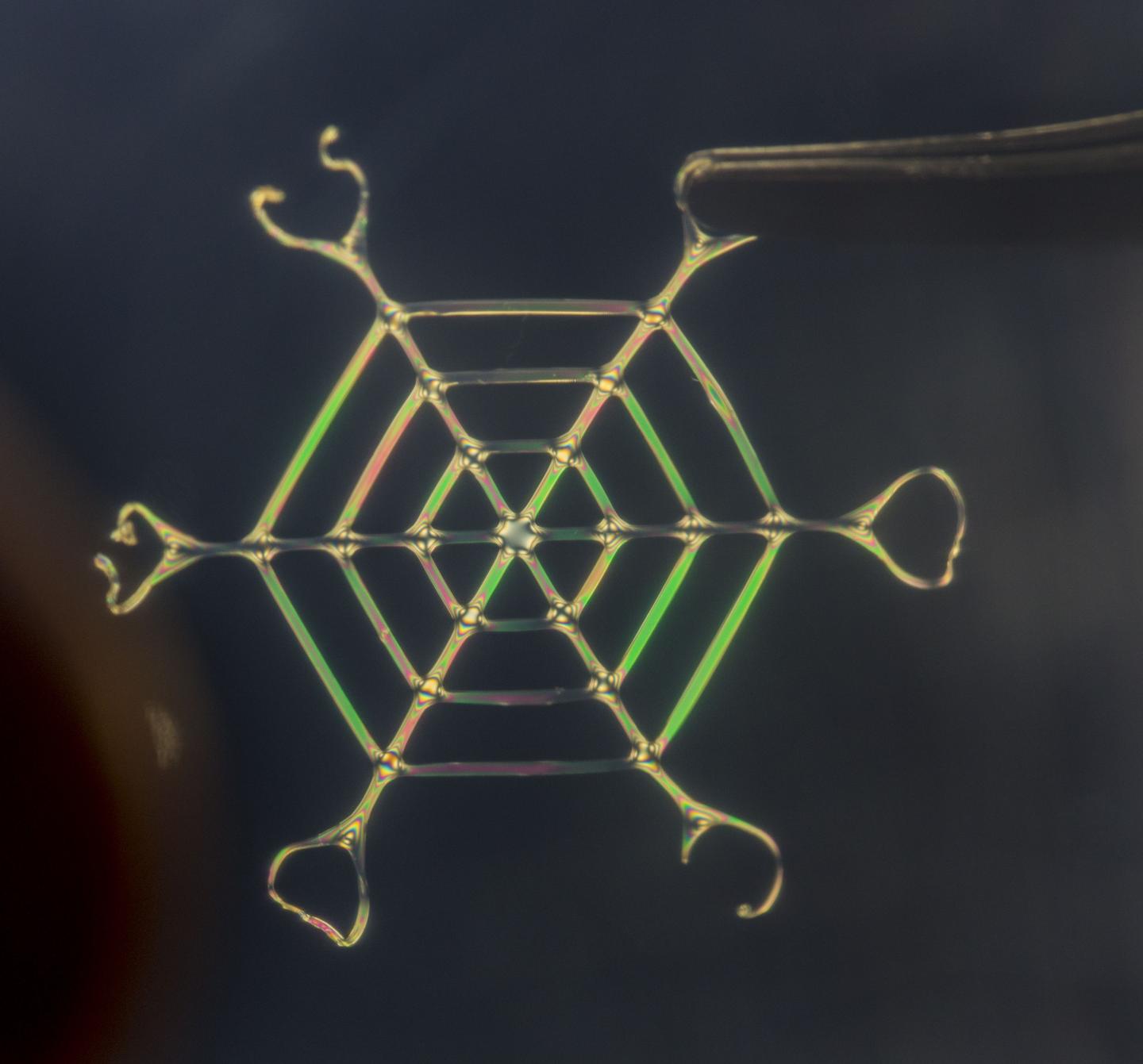
Credit: Silk Lab / Tufts University
MEDFORD/SOMERVILLE, Mass. (February 27, 2017, 11 a.m. EST) — Researchers at Tufts University's School of Engineering have developed a new bioinspired technique that transforms silk protein into complex materials that are easily programmable at the nano-, micro- and macro-scales as well as ultralight and robust. Among the varied structures generated was a web of silk nano fibers able to withstand a load 4,000 times its own weight. The research is published online in Nature Nanotechnology on February 27.
Structural proteins are nature's building blocks, forming materials that provide stiffness, structure and function in biological systems. A major obstacle to fabricating comparable synthetic materials is natural materials' hierarchical structure which confers unique properties from the molecular to the macro level. When scientists try to emulate this structure, they often find that control at one scale hinders control at other scales.
The Tufts researchers combined bottom-up self-assembly characteristic of natural materials with directed, top-down assembly to simultaneously control geometry at all scales, micro-mechanical constraints and solvent-removal dynamics–all of which determine biomaterial properties.
"We generated controllable, multi-scale materials that could be readily engineered with dopant agents. While silk is our main focus, we believe this approach is applicable to other biomaterials and composites and synthetic hydrogels," said corresponding author Fiorenzo Omenetto, Ph.D., Frank C. Doble Professor in the Department of Biomedical Engineering. Omenetto also has an appointment in the Department of Electrical and Computer Engineering and in the Department of Physics within the School of Arts and Sciences.
With the new technique, centimeter-scale silicone molds were patterned with micro-scale features no thicker than a human hair. An aqueous fibroin protein gel derived from silkworm cocoons was injected into the molds and then mechanically stressed by contraction of the gel in the presence of water and ethanol and/or physical deformation of the entire mold. As the system dried, the silk protein's structure naturally transformed to a more robust beta-sheet crystal. The material's final shape and mechanical properties were precisely engineered by controlling the micro-scale mold pattern, gel contraction, mold deformation and silk dehydration.
"The final result of our process is a stable architecture of aligned nano fibers, similar to natural silk but offering us the opportunity to engineer functionality into the material," said first author Peter Tseng, Ph.D., postdoctoral scholar in Omenetto's Silk Lab at Tufts' School of Engineering.
In some of the experiments the Tufts researchers doped the silk gel with gold nanoparticles which were able to transport heat when exposed to light.
Tseng noted that webs spun by spiders are structurally dense rather than porous. "In contrast, our web structure is aerated, porous and ultra-light while also robust to human touch, which may enable every-day applications in the future," he said. A 2 to 3 cm diameter web weighing approximately 2.5 mg was able to support an 11 gram weight.
###
Other paper authors were Bradley Napier, Tufts doctoral student in the Silk Lab; Siwei Zhao, Ph.D., post-doctoral associate in the Silk Lab; Alexander N. Mitropoulos, Ph.D., former Tufts doctoral student in biomedical engineering, now at the United States Military Academy at West Point; Matthew B. Applegate, Ph.D., former Tufts doctoral student in biomedical engineering, now at Boston University; Benedetto Marelli, Ph.D., former post-doctoral associate in the Silk Lab, now at MIT; and David L. Kaplan, Ph.D., Stern Family Professor of Engineering. Kaplan holds additional Tufts faculty appointments in the Department of Chemical and Biological Engineering, the Department of Chemistry in the School of Arts and Sciences, the School of Medicine and the School of Dental Medicine.
Support for this research came in part from the Office of Naval Research under award N000141310596. Peter Tseng received support from the National Institute of Biomedical Imaging and Bioengineering of the National Institutes of Health under the Kirschstein National Research Service Awards fellowship number F32EB021159-02. The authors also acknowledge support from the Air Force Office of Scientific Research.
Directed assembly of bio-inspired hierarchical materials with controlled nanofibrillar architectures. Peter Tseng, Bradley Napier, Siwei Zhao, Alexander N. Mitropoulos, Matthew B. Applegate, Benedetto Marelli, David L. Kaplan, Fiorenzo G. Omenetto. Nature Nanotechnology. Published online February 27, 2017. DOI: 10.1038/nnano.2017.4
Content of this news announcement is solely the responsibility of the authors and does not necessarily represent the official views of the research funders.
About Tufts University's School of Engineering
Located on Tufts' Medford/Somerville campus, the School of Engineering offers a rigorous engineering education in a unique environment that blends the intellectual and technological resources of a world-class research university with the strengths of a top-ranked liberal arts college. Close partnerships with Tufts' excellent undergraduate, graduate and professional schools, coupled with a long tradition of collaboration, provide a strong platform for interdisciplinary education and scholarship. The School of Engineering's mission is to educate engineers committed to the innovative and ethical application of science and technology in addressing the most pressing societal needs, to develop and nurture twenty-first century leadership qualities in its students, faculty, and alumni, and to create and disseminate transformational new knowledge and technologies that further the well-being and sustainability of society in such cross-cutting areas as human health, environmental sustainability, alternative energy, and the human-technology interface.
Media Contact
Kim Thurler
[email protected]
617-504-7675
@TuftsUniversity
http://www.tufts.edu
############
Story Source: Materials provided by Scienmag





